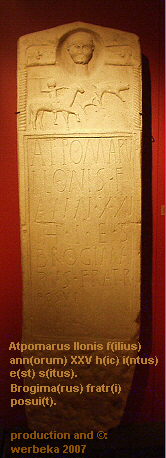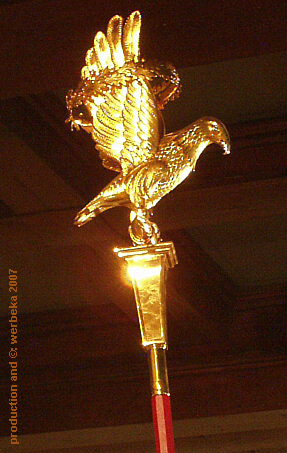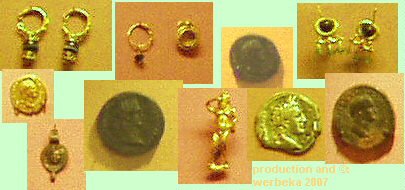
Carnuntum - the city of the Romans
| Carnuntum is situated about 40 km to the East of Vienna, almost at the Slovakian border. 2000 years ago, in the year 6 of our era, the Romans built a winter-camp there, which later became a part of the Limes, the strongly defended border of the Roman Empire against the German tribes in the North. Even Vienna, which at those times was called Vindobona, was a part of the Limes-stronghold, even if the small military fortification there was by far outdistanced in recognition by Carnuntum, the city of trade and (from about 105) the capital of Upper Pannonia. The capital of Lower Pannonia was, by the way, the city of Budapest.
Maybe Atpomarus, whose stele stands in a museum today, was one of the warriors, who had to pay with his life in one of those battles at the border? The stele was found in 1849 near Maria Lanzendorf and dates back from the first half of the first century. Translated, the Latin text would mean the following: Atpomarus, son of Ilo, 25 years of age, lies buried here beneath. Brogimarius has raised (this tombstone) in honour of his brother.
You can find this stele in the Carnuntinum, the museum of Deutsch-Altenburg, where one has collected all the findings of the entire area. Already before the Romans conquered the territory, we know that the Celts had settlements here - Boiers and Dacers were living here at least 200 years B.C. Even from this time there are findings shown in the museum. |
 |
 |
The sights in Carnuntum and Deutsch-Altenburg are situated relatively far from each other. This is why I would recommend a visit on the weekend, because then a (free) shuttlebus takes you from one place to another. But of course you can make your visit by means of public transport (Schnellbahn S7 or bus) and on foot. You will be able to see at least the two most important sights here - the museum in Deutsch-Altenburg and an excavation-site in the neighbouring village, Petronell-Carnuntum, which is shown as an open air museum. If you don't mind even longer promenades, there is in both villages an amphitheatre to look at and in Carnuntum the "Heidentor", an old port of the city wall.
But let us go back to the city of the Romans. About the year 40 Carnuntum became a fortified camp fot the 15th legion. In Emperor Hadrians years of reign (117 - 138) the Limes was completed. And it was Hadrian, who in the year 124 gave the Roman cityrights to Carnuntum. This was the cause for the growing of the civil city, which caused the need for more administration buildings and that trade not only was limited to merchandise of daily use, but that more and more articles of luxury were asked for.
|
In the later half of the 2nd century the Marcomans and the Quades - two germanic tribes - invaded the northern provinces of the Roman Empire. They couldn't be stopped before they reached Northern Italy. During this revolting times the "Austrian" Roman emperor, Marcus Aurelius (161 - 180) lived almost during three years in Carnuntum.
In 193 the governor of the province Upper Pannonia, Septimus Severus, was proclaimed Emperor by his troops on April 9th. It might have been a coup, but anyhow Carnuntum was in the center of the attention, which led to ever more enlargement of the city.

At the beginning of the 4th century, Carnuntum was to see a summit conference, when - after the resignation of Emperor Diocletian the stucture of the power in the Empire needed an overview. But the meeting failed to come to any conclusion, which led in 326 to the grab of power by Emperor Konstantin. Troughout all of the 4th century Carnuntum continued florishing.
| No wonder, because it was situated at the crossing of two very important trade routes in the north. For one part the north-southern ambertrade passed through here, for the other part Carnuntum was situated at the Danube, the natural east-western trade route. No wonder, that Carnuntum became a center for trading.
But the unrestfulness of the migrations of the tribes to the north and the east became more and more noticeable. |
 |
In 395 it were the Marcomans and Quades again, who burst through the Limes. And this time they were victorious. In 433 the northern provinces of the Romans finally were surrendered to the Huns. The Roman population migrated to the south and Carnuntum was bound to decay.
copyright Bernhard Kauntz, Wolvertem 2009
Back to  or to the or to the  of of 
5.2.2009 by webmaster@werbeka.com
|






